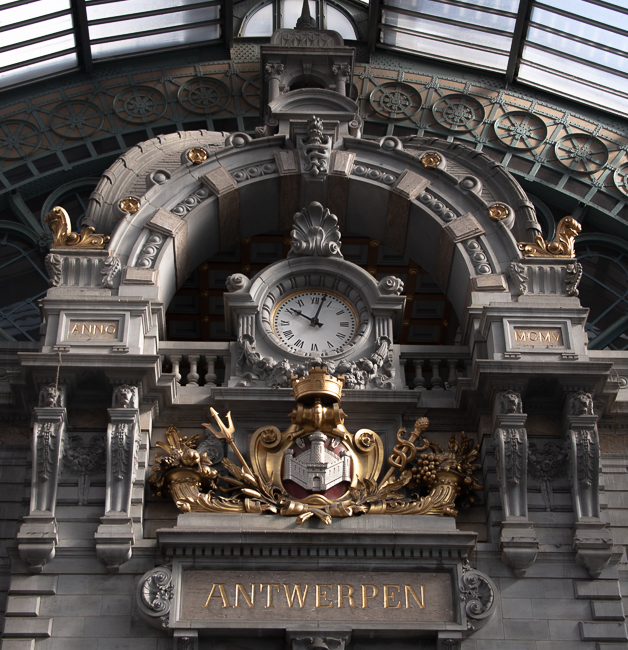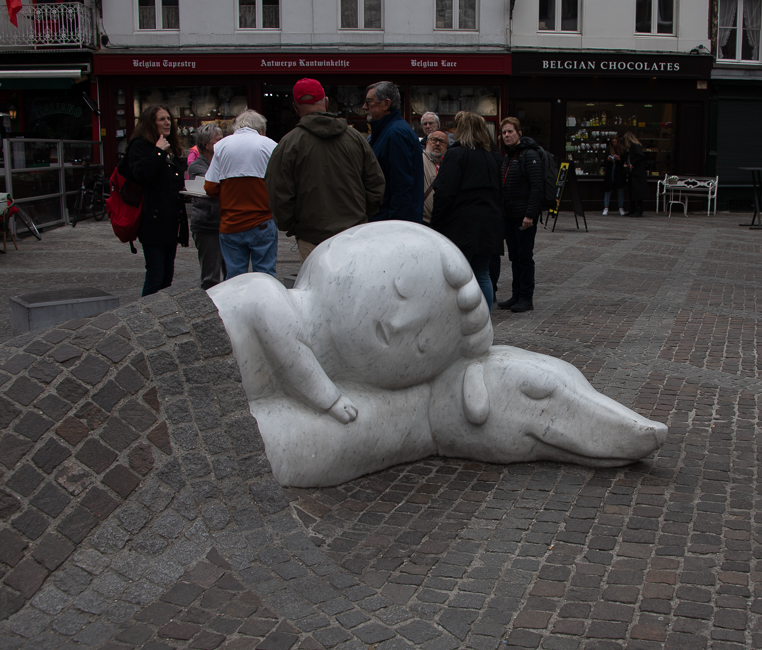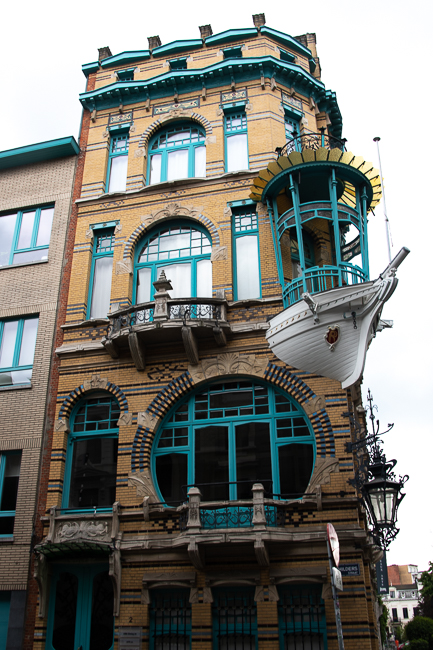April 2022
I arrived in Antwerp at the Central Rail station. Originally built between 1895 and 1905, and first used in 1905 the station was designed by Louis Delacenserie, the station is also known as the Middenstatie (Middle station) or Spoorwegkathedraal (Railroad Cathedral). Built in a rather eclectic style the station was completely renovated and in 2007. The station will take your breath away in its vastness and beauty.
In February 2009, ‘Newsweek’ found that the station “deserved a 4th place as world’s most beautiful station.”
If you wander Antwerp without knowing the legend of Druon Antigoon, you will miss so much.
Druon Antigoon is a Flemish folkloric character. He was a mythical giant who lived in Antwerp. Guarding a bridge on the river Scheldt, he exacted a toll from those crossing the river. For those who refused, he severed one of their hands and threw it into the river. Eventually, Antigoon was slain by a young Roman soldier named Brabo, who cut off the giant’s own hand and flung it into the river.
According to folklore, and as celebrated in this awkward statue in front of the town hall, this legend is the origin of the name Antwerp: Antwerpen, from Dutch hand werpen—akin to Old English hand and wearpan (= to throw), that has changed to today’s warp.
Another depiction of the legend of Antigoon is this water well. Legend has it that before painter Quintin Matsijs, started the Antwerp School of art he was a blacksmith, and fell in love with Catherina Heyns. Her father was also a blacksmith but thought that just any blacksmith was not good enough for his daughter. Masijs created the well work to prove him wrong. He married Catherina The words on the well say; “The ironwork for this well was forged by Quinten Metsijs. Love makes the blacksmith a painter.”
A DOG OF FLANDERS was written by Ouida (pseudonym of English author Marie Louise de la Ramée) in 1872. It was all about the lives of orphan Nello, who wanted to be a painter, and his dog Patrasche.
The book ends sadly when on Christmas Eve, Nello, who after being wrongly accused of causing a fire in his village, goes to the cathedral in Antwerp to see his idol Rubens’s “The Elevation of the Cross” and “The Descent of the Cross.” Finding the doors open, Nello and Patrasche spent the night in the cathedral. The next morning, they were found frozen to death under the paintings by Ruben.
The house of Peter Paul Rubens was spectacular in its day. Having bought an existing house in 1610, Rubens enlarged its adding his studio, a portico and a garden pavilion, giving the home an Italian palazzo feel, which embodied the artistic ideals of Ruben. He lived and worked in the house until his death in 1640. The building is believed to have held its original appearance until the middle of the 17th century, where it was dramatically altered. Today the portico and garden pavilion are all that is left of Ruben’s dream home. However the existing structure is now a museum to art of that era.
The medieval fortress, Het Steen was built between 1200 and 1225 as a gateway to a larger castle of the Dukes of Brabant which was demolished in the 19th century. Het Steen is Antwerp’s oldest building and used to be its oldest urban centre. The words “Het Steen” are dutch for The Rock.
There are many legends about Lange Wapper, the most prominent one from the 16th century says that a farmer found an enormous garden parsley and a red cabbage in his bed. When he touched the vegetables, they turned into a cute baby. As he was unable to take care for the child it was adopted by a family living in Antwerp. Many years later the boy helped persons in need. One day he saved an old woman who was thrown into river Scheldt by a youth gang. The old woman thanked the man by giving him some gifts such as the ability to shapeshift and to make himself so tall he could move from one town to another with a single giant leap. As he preferred to be in his tall size, he got the nickname Lange Wapper (Long Strider).
van Eyck was from Bruges, and there is a sculpture to him in that town, but while I saw it from the boat on the canal, I couldn’t find it later to photograph it. This one is in Antwerp on the Meir.
Eyck was one of the early innovators of what became known as Early Netherlandish painting, and one of the most significant representatives of Early Northern Renaissance art. According to art historians he invented oil painting.
This fun statue of Teun de Eierboer or Egg Seller is on a wall of the Grand Bazar Shopping Center. The original statue is said to have been made by Antwerp sculptor Peeter Scheemaeckers, possibly in 1683.
Art Nouveau spread across Antwerp like crazy and there are so many buildings to photograph, but this one was worth sharing.
In an attempt to push the art form over the top shipbuilder P. Roeis commissioned this house called “The Five Continents”.
Commissioned by architect Frans Smet-Verhas each of the four homes were Art Nouveau in their design, with liberal use of color, curves, and organic forms. Three of the homes still remain and can be found at the corner of Schildersstraat and Plaatssnijderstraat, in an area profuse with Art Nouveau homes.






















